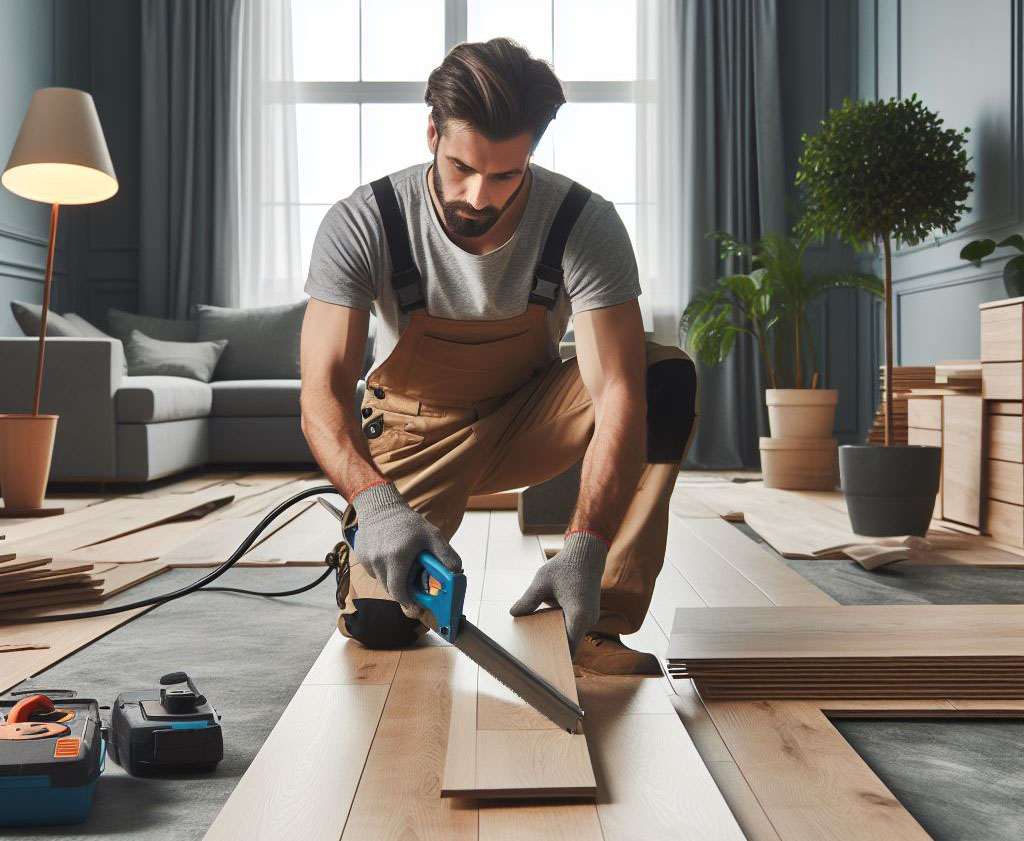Laminate wood flooring is like the Swiss Army knife of home renovation. It’s versatile, durable, and comes with a style for every taste. But, as with any tool, it’s not just what you have, it’s how you use it. Proper installation of laminate flooring isn’t just a matter of aesthetics, it’s about ensuring longevity and performance. A well-laid laminate floor can withstand the rigors of daily life, while a poorly installed one can lead to all sorts of headaches – think warping, peaking, and unsightly gaps.

Understanding Laminate Wood Floors
What’s in Laminate Flooring?
At its core, laminate flooring is a master of disguise. It’s composed of four main layers: a backing layer for stability, a core layer for durability, a decorative layer that mimics the look of real wood, and a wear layer to protect against the daily grind. This construction makes it resistant to the scratches and dents that can mar real wood floors.
Why Choose Laminate?
In the world of flooring, laminate is the practical cousin of hardwood and carpet. It offers the beauty of hardwood without the fear of damage or difficult maintenance. Cleaning is straightforward, making it ideal for those with allergies or pets. And financially, it’s a smart choice, giving you the look of luxury without breaking the bank.
Styles and Finishes
Laminate flooring is not one-size-fits-all. It offers a range of styles, from the rustic charm of barnwood to the sleek sophistication of contemporary oak. Finishes vary too – high-gloss for a modern shine or matte for a traditional feel. There’s a laminate style to suit every home décor.

Tools and Materials Needed
The Right Tools for the Job
A successful laminate flooring installation starts with the right tools:
- Tape Measure: Accuracy is key.
- Saw: Choose between a handsaw, jigsaw, or miter saw based on comfort and experience.
- Spacers: Essential for maintaining that crucial expansion gap.
- Tapping Block and Pull Bar: For snugly fitting planks.
- Hammer: A necessity for gentle adjustments.
- Utility Knife: Ideal for trimming underlayment.
The Importance of Underlayment
Underlayment is the unsung hero of laminate flooring. It’s not just about comfort, it’s about protection against moisture and evening out minor subfloor irregularities. Choose an underlayment that matches your specific needs, whether it’s moisture resistance or noise reduction.
Selecting Your Laminate
When choosing laminate flooring, consider the battlefield it will be laid upon. High-traffic areas demand a higher AC rating for durability, like AC3 or AC4. In quieter zones, a lower rating will suffice. Also, look at the warranty – it often reflects the quality and expected lifespan of the product.
Preparing for Installation
- A Clean Start: Begin with a pristine subfloor. It’s fundamental. Any grit, dirt, or debris can cause problems down the line. Think of it as prepping a canvas before painting, the cleaner it is, the better the end result.
- Measuring Matters: Precision in measurement is not just important, it’s everything. A haphazard approach can lead to awkward cuts and a less than desirable finish. Plan your layout to minimize waste and maintain symmetry – it’s about aesthetics and economy.
- Subfloor Leveling: An uneven subfloor can sabotage your installation. Using a long level, identify the highs and lows. A bit of self-leveling compound can iron out these issues. It’s like setting a solid foundation for your house – necessary and non-negotiable.
- Acclimatize Your Laminate: Like fine wine, laminate needs to breathe and adapt to its environment. Let it sit in the room for at least 48 hours. This step curbs potential warping or buckling, ensuring your floor remains steadfast and true.

Installation Process
- The First Plank: Starting in a corner, lay down your laminate with an eye on maintaining an expansion gap around the perimeter. This gap is essential for seasonal expansion and contraction. It’s a small detail that makes a big difference.
- Navigate the Nooks: When you encounter a corner or an obstacle, measure and mark the plank for cutting. A jigsaw is perfect for intricate cuts, but any fine-toothed saw will do the job. It’s about adapting to the terrain.
- Smooth Connections: As you lay each plank, use a tapping block and pull bar to ensure a snug fit. It’s about creating a seamless look where each piece appears to effortlessly blend into the next.
Finishing Touches
- Baseboards and Trim: These are not just decorative elements, they serve a practical purpose. They conceal the expansion gaps and add a polished look to your installation. Nail them to the walls, never to the floor, to allow for natural movement.
- Transitions Between Floors: Where different flooring types meet, transition strips are essential. They ensure a smooth changeover, preventing tripping hazards and adding an aesthetic touch.
- Post-Installation Care: Regular cleaning is key to maintaining the beauty of your floor. A damp mop and mild detergent are sufficient. Avoid excessive water and steam cleaning – laminate and moisture are not allies.
Troubleshooting Common Issues
Gaps and Buckling: In the world of laminate flooring, gaps and buckling are often tell-tale signs of space mismanagement. Laminate needs its breathing room, akin to a woodworker’s need for a well-organized workshop. If gaps appear, it’s usually a nudge-and-tap job using a tapping block. Buckling, on the other hand, often requires a bit more elbow grease – removing planks until you reach the culprit, trimming it for a proper fit, and then reassembling your floor puzzle.
Damaged Planks: Every seasoned renovator knows that damage is part of the journey. If a plank gets the worse for wear, don’t fret. For edge-located planks, simply disassemble to the damaged one and swap it out. If it’s center-stage, the operation is more surgical: cut out the damaged section and meticulously fit in a new piece, ensuring the pattern alignment is spot on.
Advanced Tips for Professionals
Angled Walls and Irregular Rooms: Tackling these challenges is like solving a complex puzzle. Precision is your ally. Craft a template for irregular cuts, ensuring each piece fits as snugly as a glove. The layout should always consider the room’s focal points – it’s not just about fitting the planks, but also about maintaining an aesthetic flow.
Innovative Tools and Methods: Efficiency is the hallmark of a seasoned pro. Investing in a high-quality laminate cutter can turn hours into minutes. Laser measures can ensure your measurements are spot-on, eliminating guesswork. Remember, the right tool not only saves time but also elevates the quality of your work.
FAQ Section
Yes, but with considerations. Over tiles, ensure they’re level and devoid of debris. Carpets, particularly thick ones, are generally a no-go due to stability concerns. It’s like building on a solid foundation versus a cushion.
Moisture and laminate are a tricky pair. Always incorporate a moisture barrier over concrete. In humid environments, maintaining a consistent room humidity, ideally between 35-65%, is crucial. Think of it as creating a stable environment for the material to perform at its best.
Absolutely. Expansion gaps are the unsung heroes in preventing buckling and other distress in laminate floors. A quarter-inch gap usually does the trick, allowing the floor to expand and contract with seasonal changes.
Certainly. Opt for laminate with a higher AC rating, like AC3 or above, which are designed for these demanding environments. It’s like choosing the right grade of lumber for a heavy-load-bearing structure.
The devil is in the details. Use a jamb saw to cut door frames for a flush fit. For fixtures, precise measurement and cutting are key. Sometimes, a pull bar is needed to coax the final plank into position, ensuring a tight, professional finish.
